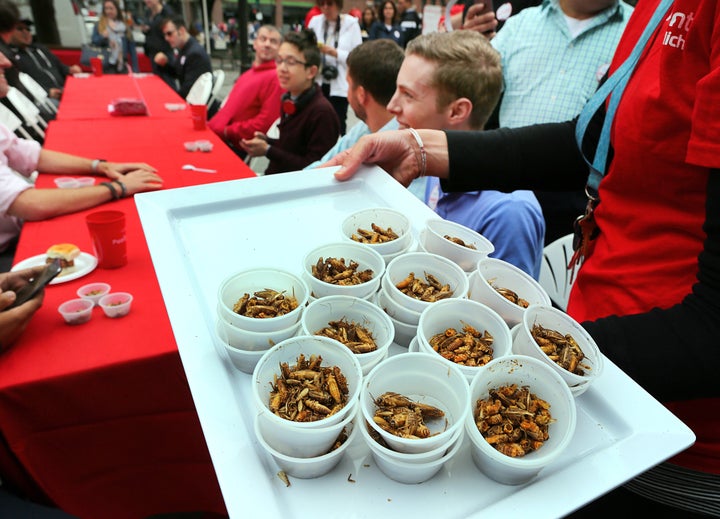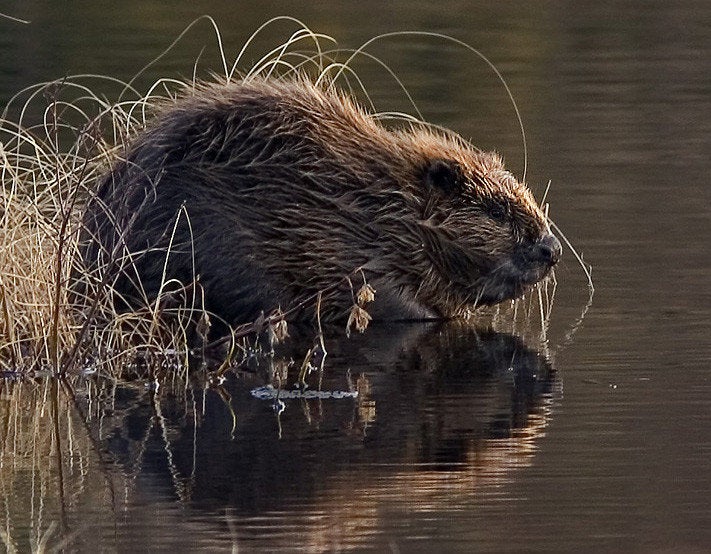
If you ask the average American about eating bugs, their response will likely range from disgust to polite curiosity at best.
But in the eyes of New York-based filmmakers Johanna B. Kelly and Cameron Marshad, that could be about to change.
The two have embarked on a new feature-length documentary, titled “The Gateway Bug,” that delves into the current state of America’s edible insect industry. A state, they say, is booming thanks in no small part to the environmental and nutritional advantages insects present amid questions of how the world will feed some 9 billion people by the year 2050.
Over the course of just a few months, the duo has accumulated 60 hours of footage including interviews with key players in the nascent industry and, this week, they launched a Kickstarter campaign to raise funds for them to complete post-production work on the film, which they hope to finish in February.
To learn more about why we’ll probably all be chomping down on crickets in the not-so-distant future, The Huffington Post recently spoke with Kelly and Marshad.
HuffPost: What motivated you to make this documentary? Why do you think it’s such an important issue to be digging into right now?
JK: I really think there are three really critical parts to this movement. You’ve got the environmental part and that really is huge importantly to us. We think there’s lots of misinformation being spread around about the causes of our environmental climate problem and we want to get the facts out there and get people really educated on those issues.
We also have huge problems with obesity and diabetes and nutrition in America. I don’t think it’s enough to educate people on the problem. What you need to do to make significant change is to show strategies around that and offer solutions -- otherwise it’s a very bleak outlook. The edible insect industry does that.
CM: It’s also interesting to see how many people around the world already eat insects and how in the west we’ve been trying to keep insects away from us and kill them for such a long time with the use of insecticides and pesticides, which so much of our agricultural system is based on. It’s a groundbreaking thing to start eating these insects. A lot of people around world already eat them and they’re extremely nutritious, and part of our movie really does touch on the stigma but doesn’t really focus on how “gross” they are. It really talks about the positive aspects of eating bugs.
The title for the film is “The Gateway Bug” and your trailer names the specific “gateway” bug as the cricket. How did you choose that title and why do you think that is?
JK: To tell the truth, the title came from our documentary. After watching all the footage, we found that almost everybody said that line. And we’re not so much saying that crickets are the gateway bug, we’re asking the question if they are. The industry is definitely moving very fast and crickets seem to be at center of it but, as with all farming and food production, the first thing that proves successful isn’t always the best thing and isn’t the one that will carry it forward.
There are lots of variables to trying to predict American palates for the future. The palate seems pretty abused at this time with high sugar and high fructose corn syrup, but I think we’re in the process of a huge overhaul right now as more people become educated and more information comes to light about the damaging effects the ingredients of your diet might have on your health and physical wellbeing. We feel that as that escalates, which it no doubt will, a lot of people will be looking for alternatives and perhaps the cricket will lead them down that path.
CM: I think there actually is a good reason why it’s called the gateway bug, however. It’s because crickets have been farmed in the U.S. for the reptile feed market for the last 50 years. There’s an infrastructure created around it that only recently has been approved for human consumption and had infrastructure designed for that. That’s not to say other bugs are not worthy of human consumption. But crickets contain a lot of protein, they’re crunchy and they’re one of the most palatable insects out there, I’d say.
In the trailer, Dr. Sonny Ramaswamy of the USDA suggests that the biggest obstacle to this industry’s growth is consumer taste. Do you agree?
CM: I don’t think consumer taste is what’s preventing this from taking off. Through our investigation, we’ve seen demand for this really outstripping supply and I think it’s really going to take off through more products being created and supply being generated. That’s really going to happen through advancements in agricultural technology. We interviewed specific companies that are developing amazing technology that will allow for the mass production of crickets in the near future. I think that’s really what’s stopping it.
JK: The problem isn’t being helped that it’s pretty difficult to get these products on the shelves until very recently, I would imagine. But I feel we are making progress in this area. I think we’ll see various cricket products flying into Whole Foods or Trader Joe’s or other places where people are already interested in products based on their health benefits and environmental impact more so than their price point or taste. The other issue is the yuck factor. The way that’s being tackled right now is through the usual way of making things palatable: Grinding it up, making flour and using that flour in products. It’s much harder to be grossed out by it then when you’re looking at a protein bar that looks like all the other protein bars.

What were some of the most surprising things you learned along the process of shooting this film?
JK: I was really surprised with the amount of products on the shelves. When I started opening my eyes, I realized there were so many already out there.
CM: The biggest surprise for me is that it went way beyond human consumption and that there were a number of companies looking into feeding animals. The first person we met doing this -- Tyler Isaac [of Slightly Nutty] in Santa Barbara -- had the idea to take the boiled grains that a brewery would normally throw away and instead feed them to crickets and take them and create insect meal and feed that to fish or chickens, both of which are natural insectivores. It solves part of the food waste problem we have today, too. A lot of really valuable resources and lots of money, water and fertilizer go into creating food that just goes to waste.
JK: Essentially he’s converting waste into protein and creating something to feed people.
Do you feel we've reached a point where eating bugs is genuinely on the cusp of going mainstream here in America?
JK: I think we’re extremely close. One of the prime reasons we’re making this film is we considered ourselves educated, foodie, environmentalist type people who are pretty much no board with all that. We watch Jon Stewart, you know what I mean? And we had not heard of this, it wasn’t on our radar at all! So, suffice it to say, we’re trying to get it on the radar. We’re confident based on supply and demand and the number of businesses starting out.
We interviewed Andrew Zimmern of "Bizarre Foods" and he said there were no cricket flour products when he started in the industry and now he’s inundated with people talking about it. Once we get the chance to share this film, you won’t be asking if it’s on the cusp. We’ve traveled all over the U.S. and Canada, where you expect people to have more of that yuck factor than they are in reality. Mostly you’ll find people who are kind of curious. And curiosity is a great thing. It’s where education and knowledge stem from.
This interview has been edited for length and clarity.
Joseph Erbentraut covers promising innovations and challenges in the areas of food and water. In addition, they explore the evolving ways Americans are identifying and defining themselves. Tips? Email joseph.erbentraut@huffingtonpost.com.
Also on HuffPost:
